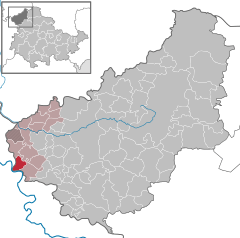Lindewerra
From Wikipedia, the free encyclopedia
| Lindewerra | ||
|---|---|---|
 | ||
| ||
 Lindewerra | ||
Location of Lindewerra within Eichsfeld district 
 | ||
| Coordinates: 51°18′49″N 9°56′53″E / 51.31361°N 9.94806°ECoordinates: 51°18′49″N 9°56′53″E / 51.31361°N 9.94806°E | ||
| Country | Germany | |
| State | Thuringia | |
| District | Eichsfeld | |
| Municipal assoc. | Hanstein-Rusteberg | |
| Government | ||
| • Mayor | Manfred Sippel | |
| Area | ||
| • Total | 4.40 km2 (1.70 sq mi) | |
| Elevation | 150 m (490 ft) | |
| Population (2012-12-31)[1] | ||
| • Total | 247 | |
| • Density | 56/km2 (150/sq mi) | |
| Time zone | CET/CEST (UTC+1/+2) | |
| Postal codes | 37318 | |
| Dialling codes | 036087 | |
| Vehicle registration | EIC | |
| Website | www.lindewerra.de | |
Lindewerra is a municipality in the district of Eichsfeld in Thuringia, Germany. It is part of the Verwaltungsgemeinschaft Hanstein-Rusteberg. Before the fall of the Berlin Wall in 1989 Lindewerra was one of the few villages in the German Democratic Republic that could be observed directly from the West. After the fall of the Berlin Wall a bridge was built to connect the village to the Hessian bank of the Werra River.
| Wikimedia Commons has media related to Lindewerra. |
References
- ↑ "Bevölkerung der Gemeinden, erfüllenden Gemeinden und Verwaltungsgemeinschaften nach Geschlecht in Thüringen". Thüringer Landesamt für Statistik (in German). 13 July 2013.
This article is issued from Wikipedia. The text is available under the Creative Commons Attribution/Share Alike; additional terms may apply for the media files.
